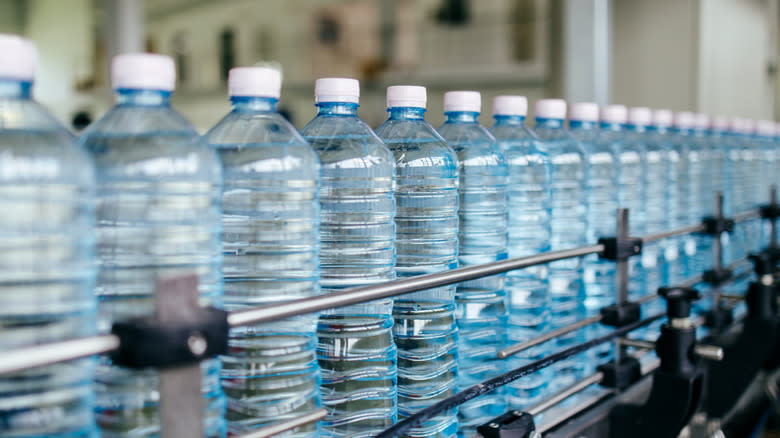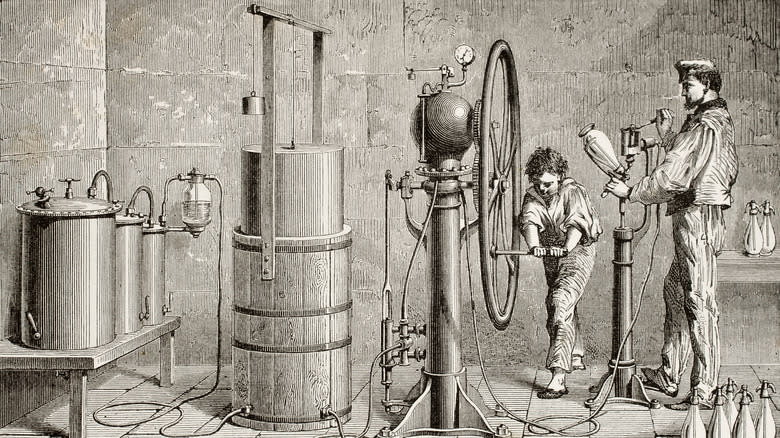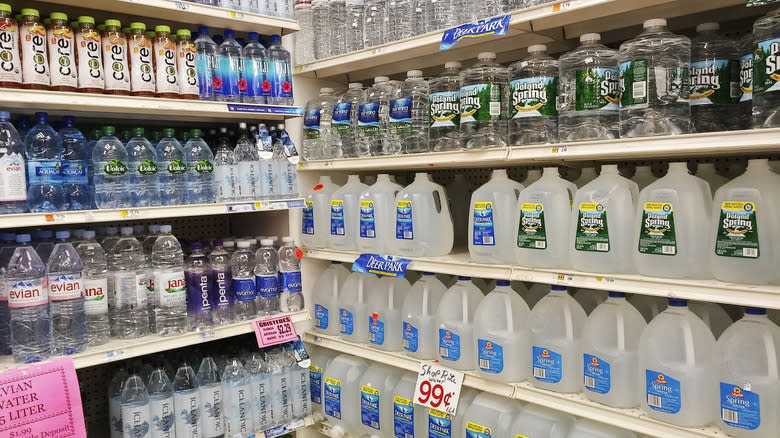Bottled Water Was Originally Created For Medicinal Purposes

If you buy bottled water, why do you do it? Maybe you like the convenience or the taste. Maybe you believe it's healthier than tap water. Or maybe — it's okay to admit it! — you're enticed by clever marketing from brands like Evian and Liquid Death.
For centuries, people have bought water for many of the same reasons. Monks sold bottled holy water to pilgrims during the Middle Ages, but it wasn't until the 16th and 17th centuries the industry took off. At the time, wealthy Europeans often vacationed at springs and spas, drawn by the promise of relaxation and restorative waters.
For thousands of years, people have believed that mineral water — untreated water that flows fresh from the ground — has medicinal properties. Even now, medical science agrees that mineral water may have health benefits. As the water flows through the earth, it picks up minerals from deposits in the ground. Many minerals, like calcium and magnesium, help our bodies function.
Since different springs featured different mineral deposits, each spa boasted unique health benefits. Soon, enterprising locals started selling tourists bottled water as souvenirs. The practice spread as a way for those who couldn't afford spa trips to experience the medicinal properties. Many of the bottled water brands found on grocery store shelves date back to this era: Evian opened its first bottling facility in 1826, and in 1845, Poland Spring became one of the first bottled water companies in the United States.
Read more: 26 Coffee Hacks You Need To Know For A Better Cup
Bottled Water Inspired Modern Soft Drinks

Schweppe's, known for its popular tonic water, is one of those early brands. In the 1700s, a Swiss jeweler named Jacob Schweppe started selling artificially carbonated water, establishing the foundation for the modern soft drink industry. Until the 1760s, carbonated water was only available from springs. Doctors believed carbonated spring water was particularly healthy, but it wasn't accessible to the general public.
Schweppe didn't invent the carbonation process, but he did perfect it. Initially, he donated his carbonated water to those who couldn't afford spa trips; as his business grew, he started charging a small fee. Soon, Schweppe started selling water with different combinations of minerals to target specific ailments. Schweppe's bottled water inspired copycats, and before long the industry was booming — buoyed by new technologies that made it cheaper and easier to produce glass bottles.
When Schweppe's started adding flavors and sweeteners to their drinks, imitators were quick to follow. As brands vied for customers' attention, fruity flavors and health tonics sweetened with syrup started to hit the market — and the world fell in love with soft drinks.
Bottled water sales sank when brands like Coke and Pepsi hit the mainstream. But it wasn't just because customers preferred sugary drinks. After a 1905 typhoid epidemic, public health reformers began chlorinating American water supplies. Americans no longer needed bottled water; they had clean water readily available at home.
Bottled Water Bounces Back

In the late 1970s, Perrier hatched a plan to enter the American market. At the time, Americans viewed bottled water as decadent — which Perrier capitalized on with a series of high-budget TV ads narrated by Orson Welles. The ads promoted Perrier as natural, sophisticated, and French: "Deep below the planes of Southern France ... Nature herself adds life to the icy waters of a single spring: Perrier," the Hollywood legend says in a silky baritone. Perrier's campaign worked. In the late '70s and early '80s, Americans started seeing health and wellness as status symbols — and Perrier became a fashion accessory.
Perrier's popularity declined in the early '90s after contamination at a bottling plant led to a worldwide recall. By then, the U.S. market was full of brands vying to take Perrier's place. Despite the Perrier recall, Americans started to see bottled water as a healthy alternative to tap. This was partially due to a concentrated effort by water companies and partially due to scandals that called municipal water's quality into question.
Bottled water dipped in popularity during the recession, but came back in full force. In 2016, it overtook soda as America's most popular bottled drink. Some water brands flaunt a premium image, while others boast unique flavors or hail from exotic locals. People still buy bottled water for its medicinal properties, too. Check your grocery store shelves, and you'll see water fortified with vitamins and minerals — a callback to the industry's roots.
Read the original article on Tasting Table

